
Fouquieria columnaris, the Boojum tree or cirio is a tree in the ocotillo family,(Fouquieriaceae) whose other members include the ocotillos. Some taxonomists place it in the separate genus Idria. It is nearly endemic to the Baja California Peninsula, with only a small population in the Sierra Bacha of Sonora, Mexico. The plant's English name, Boojum, was given by Godfrey Sykes of the Desert Laboratory in Tucson, Arizona and is taken from Lewis Carroll's poem "The Hunting of the Snark".

Euphorbia is a very large and diverse genus of flowering plants, commonly called spurge, in the spurge family (Euphorbiaceae). "Euphorbia" is sometimes used in ordinary English to collectively refer to all members of Euphorbiaceae, not just to members of the genus. Some euphorbias are commercially widely available, such as poinsettias at Christmas. Some are commonly cultivated as ornamentals, or collected and highly valued for the aesthetic appearance of their unique floral structures, such as the crown of thorns plant. Euphorbias from the deserts of Southern Africa and Madagascar have evolved physical characteristics and forms similar to cacti of North and South America, so they are often incorrectly referred to as cacti. Some are used as ornamentals in landscaping, because of beautiful or striking overall forms, and drought and heat tolerance.

Chamaesyce is a genus of plants in the family Euphorbiaceae. Recent phylogenetic studies have shown that Chamaesyce is deeply nested within the broader Euphorbia. Specifically, Chamaesyce is very closely related to plants like Euphorbia pulcherrima, the popular poinsettia. Currently, all species have now been reclassified as species of Euphorbia. Specifically, this group now belongs to Euphorbia subgenus Chamaesyce section Anisophyllum. Taxonomically speaking, Chamaesyce is considered a synonym of Euphorbia.

Coastal sage scrub, also known as coastal scrub, CSS, or soft chaparral, is a low scrubland plant community of the California coastal sage and chaparral subecoregion, found in coastal California and northwestern coastal Baja California. It is within the California chaparral and woodlands ecoregion, of the Mediterranean forests, woodlands, and scrub biome.

Agave shawii is a species of monocarpic succulent plant in the genus Agave, commonly known as Shaw's agave. It is a rosette-forming plant characterized by glossy, green leaves with toothed margins. After several years of slow growth, the plant puts all of its resources to produce a towering stalk of flowers, and then dies. The death of the flowering rosette is compensated by the growth of numerous clonal pups. This species is segregated into two subspecies, one native to the coast of southwestern California and northwestern Baja California, known commonly as the coast agave, and another native to the Baja California Desert, known as the Goldman agave.

Ornithostaphylos is a monotypic plant genus which contains the single species Ornithostaphylos oppositifolia, commonly known as the Baja California birdbush or Baja California manzanita. A large, evergreen shrub in the heather family, this species is near-endemic to northwestern Baja California, with a small population just north of the border in San Ysidro, California. It produces a much-branched inflorescence of white, urn-shaped flowers, and has leathery leaves that appear opposite or in whorls. These unique characteristics separate it from its close relatives in the region, which include manzanitas (Arctostaphylos), summer holly (Comarostaphylis) and mission manzanita (Xylococcus).
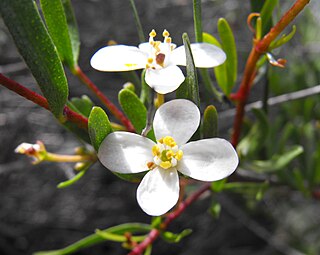
Cneoridium is a monotypic genus in the citrus family which contains the single species Cneoridium dumosum, commonly known as bushrue or coast spice bush. This perennial, evergreen shrub is native to the coast of southern California and Baja California, thriving in hot, dry conditions. This plant is characterized by a distinctive citrusy aroma and small, white flowers that appear from winter to spring. The flowers eventually become round berries that resemble a miniature version of the common citrus fruit.
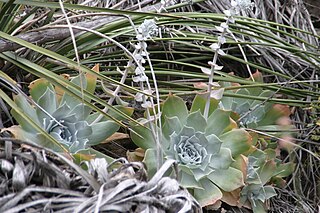
Dudleya pulverulenta is a species of perennial succulent plant known by the common names chalk lettuce, chalk dudleya, and chalk liveforever. It is one of the larger Dudleya, with a silvery, waxy rosette that may greatly contrast with its habitat. It is also regarded as one of the most distinctive members of the Dudleya, with the most advanced inflorescence in the genus, consisting of pendant, hummingbird pollinated flowers, the longest corolla, and the highest nectar output, along with the largest range of all the Dudleya, over 1000 kilometers, being found from Monterey County in California to the Sierra de San Borja in southern Baja California.
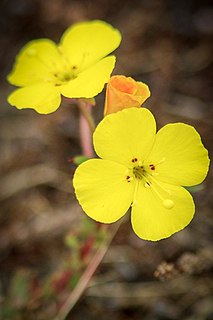
Camissoniopsis bistorta is a species of flowering plant in the evening primrose family known by the common names southern suncup and California suncup. It is native to southern California and Baja California, where it grows in several types of plant community along the coast and in the coastal hills and mountain ranges. This is a hairy annual or short-lived perennial herb spreading from a basal rosette, with stems reaching up to 80 centimeters long. The leaves are narrow and sometimes toothed, and 1 to 12 centimeters in length. Toward the end of the spreading stems are nodding inflorescences of flowers, each flower with four bright yellow petals dotted with red at their bases.
Euphorbia hooveri is a species of euphorb known by the common names Hoover's sandmat and Hoover's spurge. It is endemic to California, where it grows in the rare vernal pools of the Central Valley. Due to the elimination of most of its habitat, it became a federally listed threatened species in 1997.

Euphorbia melanadenia is a species of Euphorbia known by the common name red-gland spurge. It is native to the deserts and mountains of Baja California and southern California and Arizona, where it grows in dry, rocky habitat. It is a perennial herb forming a small clump or mat of very slender, tangling red stems. The stems are lined with pairs of slightly woolly oval-shaped leaves 2 to 9 millimeters wide. The tiny inflorescence is a cyathium less than 2 millimeters wide. The cyathium is a bell-shaped array of white, scalloped petal-like appendages surrounding the actual flowers. Each appendage has at its base a shiny red nectar gland. At the center of the appendages is a ring of male staminate flowers around a single female flower. The female flower develops into an oval-shaped fruit which bears wrinkled white seeds.
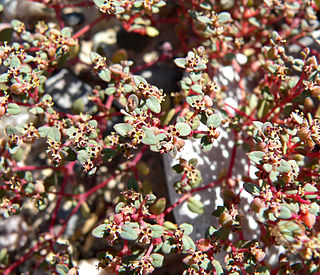
Euphorbia micromera is a species of flowering plant in the family Euphorbiaceae. It is known by the common name Sonoran sandmat. It is native to the southwestern United States from California to Texas, and northern Mexico, where it grows in sandy soils in desert and other dry habitat. It is an annual herb forming a small mat of slender stems. The hairy to hairless leaves are oblong in shape and just a few millimeters long. The tiny inflorescence is a cyathium less than a millimeter wide. It lacks the appendages that many similar species have in their cyathia. It has only a central female flower and 2 to 5 male flowers surrounded by round red nectar glands. The fruit is a minute round capsule.

Euphorbia nutans is a species of Euphorbia known by the common names eyebane and nodding spurge. It is native to much of the United States, Eastern Canada, Mexico, Central America, the Caribbean, and Venezuela.
Euphorbia ocellata is a species of Euphorbia known by the common name Contura Creek sandmat. It is native to the southwestern United States where it grows in many types of habitats. This is a small annual herb with pairs of oblong to lance-shaped leaves, each leaf up to about 1.5 centimeters long. The inflorescence is a cyathium only 2 millimeters wide. It consists of petal-like appendages surrounding the actual flowers, each with a round nectar gland at its base. The appendages are sometimes absent. The flowers include one female flower ringed by up to 60 male flowers. The fruit is a lobed, spherical capsule less than 3 millimeters wide.

Euphorbia prostrata is a species of spurge known by the common name prostrate spurge or prostrate sandmat.
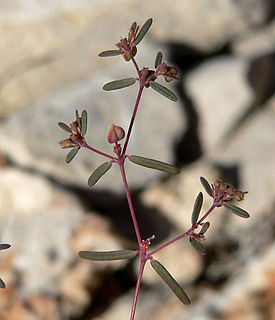
Euphorbia revoluta is a species of euphorb known by the common name threadstem sandmat. It is native to Mexico and the southwestern United States from California to the Rocky Mountains. It is an annual herb producing thin, erect stems with pairs of linear leaves, each leaf up to 2.6 centimeters long. The inflorescence is a cyathium with rounded nectar glands surrounding one female flower and several male flowers. There are sometimes white petal-like appendages as well. The Navajo used this plant as a skin lotion.
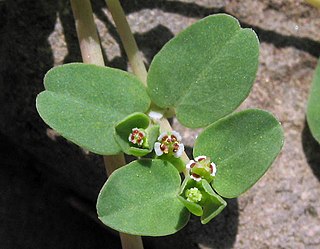
Euphorbia serpens is a species of Euphorbia known by the common name matted sandmat. It is native to South America but it can be found on most continents as an introduced species and often a weed. This is an annual herb forming a mat of prostrate stems which root at nodes where the stem comes in contact with the ground. The oval leaves occur in oppositely arranged pairs, each leaf less than a centimeter long. The inflorescence is a cyathium with scalloped white petal-like appendages surrounding the actual flowers. A red nectar gland is at the base of each appendage, and at the center of the cyathium are several male flowers around one female flower. The fruit is a lobed, spherical capsule.

Euphorbia balsamifera is a flowering plant in the spurge family Euphorbiaceae. It is distributed in the Canary Islands and the western Sahara. It is the vegetable symbol of the island of Lanzarote. Euphorbia adenensis has been treated as a subspecies of this species.

Euphorbia schizoloba is a species of euphorb known by the common name Mojave spurge. It is native to the southwestern United States, where it grows in desert hills and mountains. It is a perennial herb producing upright stems up to 40 centimeters tall, sometimes with coats of sparse hairs. The stems are lined with alternately arranged leaves which are oval with pointed tips and measure up to 2 centimeters in length. The inflorescence is a cyathium with bell-shaped bracts surrounding four tiny glands with flat, fringed appendages. At the center of this arrangement are several staminate flowers and one long pistillate flower.

Dudleya ingens is a species of perennial succulent plant in the family Crassulaceae commonly known as the rock liveforever or Baja liveforever. A relatively large member of the genus Dudleya, this species has long green succulent leaves, and in April to June is characterized by pale yellow to white pink-tinged flowers topping tall, reddish inflorescences. It has a stem clothed densely with old, leathery leaves, and the inflorescence may be nodding, with the floral branches bearing the flowers tending to unfurl like the fronds of a fern. It is similar in appear to Dudleya brittonii, but differs in range and chromosome number. This species is endemic to the state of Baja California in Mexico, being found from Santo Tomás to the southern coast of the state.

























